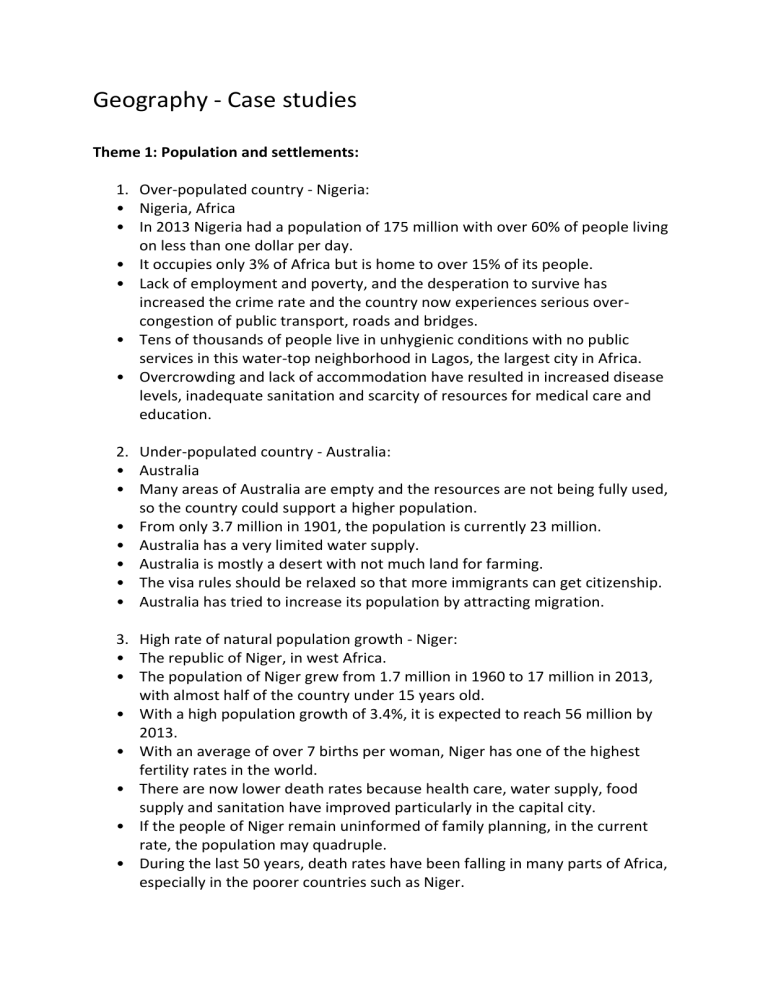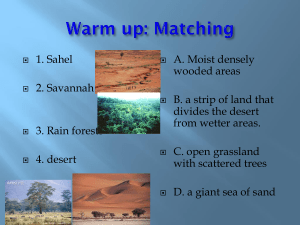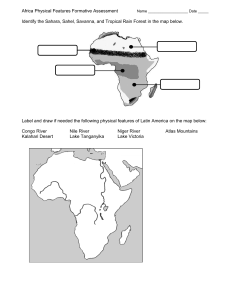
Geography - Case studies Theme 1: Population and settlements: 1. Over-populated country - Nigeria: • Nigeria, Africa • In 2013 Nigeria had a population of 175 million with over 60% of people living on less than one dollar per day. • It occupies only 3% of Africa but is home to over 15% of its people. • Lack of employment and poverty, and the desperation to survive has increased the crime rate and the country now experiences serious overcongestion of public transport, roads and bridges. • Tens of thousands of people live in unhygienic conditions with no public services in this water-top neighborhood in Lagos, the largest city in Africa. • Overcrowding and lack of accommodation have resulted in increased disease levels, inadequate sanitation and scarcity of resources for medical care and education. 2. Under-populated country - Australia: • Australia • Many areas of Australia are empty and the resources are not being fully used, so the country could support a higher population. • From only 3.7 million in 1901, the population is currently 23 million. • Australia has a very limited water supply. • Australia is mostly a desert with not much land for farming. • The visa rules should be relaxed so that more immigrants can get citizenship. • Australia has tried to increase its population by attracting migration. 3. High rate of natural population growth - Niger: • The republic of Niger, in west Africa. • The population of Niger grew from 1.7 million in 1960 to 17 million in 2013, with almost half of the country under 15 years old. • With a high population growth of 3.4%, it is expected to reach 56 million by 2013. • With an average of over 7 births per woman, Niger has one of the highest fertility rates in the world. • There are now lower death rates because health care, water supply, food supply and sanitation have improved particularly in the capital city. • If the people of Niger remain uninformed of family planning, in the current rate, the population may quadruple. • During the last 50 years, death rates have been falling in many parts of Africa, especially in the poorer countries such as Niger. 4. Population decline - Russia: • Russia • The population of Russia in 2013 was 143 million. In 1991, the population was at its highest but it has decreased mainly due to high death rate. • Russian women are highly educated, so they do not want large numbers of children. • Immigration into Russia is low. • Many emigrants are moving to western Europe in search for a better lifestyle. • Alcohol-related deaths in Russia are very high, levels of HIV/AIDS, heart disease and tuberculosis make the life expectancy very low. • The population between 1960 and 2100 is predicted to decrease from 103 million to 68.69 million. 5. International migration - Qatar: • Qatar, western Asia. • Life in Qatar before 1930 involved widespread poverty, malnutrition and disease. • Most people worked in the pearl fishing industry, but that collapsed when the Japanese began to make artificial pearls. • In 1971, it became an independent state and began to use oil revenue. • Since 1995, increasing oil prices and political stability have helped to create one of the fastest growing economies in the world. • Gaining such enormous wealth in such a short time span has meant that the development of the country has relied on using overseas companies who employ foreign migrants to construct houses, hotels, offices, and infrastructure such as schools and roads. • In 1935, the arrival of oil prospectors signaled a new future for the state. The second world war of 1939 - 45 delayed oil production for 10 years but, once production began, the oil income changed this tiny, impoverished nation into on with the second highest per capita income in the world. 6. High dependency - Italy: • Italy, central Europe • Italy has more than 60 million residents, with a population density of 201/km2 - one of the highest in Europe. • Italy has one of the highest dependencies in Europe. • Although death rates and birth rates are low, the death rate has been higher than the birth rate for over a decade. There is negative population growth. • More people are reaching 65 and there are too few young people coming through to replace them. • In most Italian regions is the high degree of dependency of the young and old on the working population, much of which is boosted by net migration into the country. • Working population narrow at the bottom so will not replace the top as they retire. 40 - 49 is the widest age group for future work but they will have retired in 25 years or less. 7. High population density - Japan: • Japan, Asia. • Japan is one of the most densely populated countries in the world with a population density of over 350/km2. • Some parts of japan are densely populated whereas some parts have very few people. • Outside the urban areas, on the flat valley floors and gently sloping lower slopes of Honshu and Kyushu are high density rural areas. • These areas are densely populated because crops can easily be grown on the fertile soils of the flat or gently sloping land. • Almost a half of Japan’s population live in the areas around Tokyo, Nagoya and Osaka. • Over two-thirds of japan is mountainous so there is not enough flat land to grow food on. 8. • • • • • Low population density - Namibia: The republic of Namibia, southwest Africa. With an overall population density of 2.6/km2, it is very sparsely populated. Much of the country has a hot and dry climate. Rainfall is sparse and erratic and there are prolonged periods of drought. The economy is dependent on the extraction and processing of minerals such as diamonds and uranium for export. • Mining employs only about 3% of the population while about half of the population depends on agriculture. • Caprivi has the highest population density (5.5/km2) and Otjozondjupa has the lowest population density (1.3/km2). 9. Settlement hierarchy - Sardinia: • Sardinia is an Italian island in the Mediterranean Sea with a total population of about 1.7 million people. • Until recently, most of the population lived in inland areas, and the economy was based on agriculture and the mining of coal, lead and zinc. • In the last 50 years, tourist development has taken place in the coastal areas. • Cagliari, the capital city is the main commercial and industrial center of the island. It has on the largest fish markets in Italy. • Carbonia was built to provide housing for the workforce of the nearby mines. • The small town of Bosa is situated on the west coast of Sardinia. Its beach has been voted the most beautiful beach in Italy and the town is growing in popularity for tourism. • Olbia is a town of over 50 000 inhabitants in north-east Sardinia. It has an important airport, passenger port and railway. 10. Urban area - Atlanta, USA: • Atlanta is the capital city of Georgia. • Its population has grown from 2 million in 1970 to over 6 million in 2013 - the fastest-growing metropolitan city in the USA. • Recent population growth has been caused by newcomers from cities around the Great Lakes and the north-east. • This growth has resulted in many problems, including traffic congestion, air pollution, lack of affordable housing and urban sprawl. • Plans include investment in public transport which combines light rail with new pedestrian and bike links. • Brownfield sites are being regenerated in the city rather than further extending the city’s boundaries and building on greenfield sites. • Expansion has meant that farmland has been bought and covered with shopping malls and other developments. 11. Urbanization in Peru - Lima: • Lima, the capital city of Peru. • About 30% of Peru’s 29.5 million people live in the capital city. • In 1940, 10% of Peru’s population and most of the population lived in rural areas. • As Peru’s population has grown, more people have chosen to move away from their villages and small towns to the capital city, where they hope for a better life for themselves and their children. • Due to steep slopes and the unpredictable climate, farming is a difficult job and yields are often low. • In villages such as Cusipata in the Peruvian Andes, traditionally family members have worked for part of the year in nearby large towns such as Cuzco and Huancayo. • Increasing numbers of men and women are leaving Cusipata to migrate permanently to Lima to find work in the capital city. Theme 2: The natural environment: 12. A volcano - Mt. Sinabung: • Mt. Sinabung, Indonesia. • Mt. Sinabung was dormant for about 400 years until eruptions in August 2010, September 2013 - February 2014. • Most of the volcanoes are found on the western coast of Sumatra • The ring of fire in the Pacific Ocean, makes Indonesia the country with the greatest number of volcanoes. • Mt. Sinabung is located in the northern edge of the island of Sumatra. • The eruptions in the February of 2014 was the most violent and dangerous one of all of them, spewing rock, toxic gas and ash. • There were no casualties from the explosions other than the one in February, where 16 people were killed. 13. Earthquake - Haiti: • Haiti • The earthquake took place on 12th January 2010 at 5pm. • The epicenter of the earthquake was 16 km away from Port-au-Prince, the capital city. • The focus was only 10km under the ground, sending shallow shockwaves that caused great damage. • It had a magnitude of 7, with some places experiencing 4.5 and some greater than 5. • Over 220 000 people were killed and over 250 000 houses were destroyed with many more people displaced. • The earthquake was caused by the sliding of the north American and Caribbean tectonic plates. 14. The Elbe river: • The Elbe river, Czech Republic. • The Elbe river is one of the major waterways of Europe. It rises in the Czech Republic, flowing through Germany and then entering the North Sea. • People living close by have experienced floods and subsequent damage as rivers reached their highest levels since 1954. • Extreme flooding began several days after heavy rain between 30 may and 2 June, when up to 250mm of rainfall fell in some areas. • A state of emergency was declared and 23000 residents were asked to leave their home when a dam burst. • There are also hazards, notably flooding. The management of this flooding has faced many challenges in the recent years, but in 2013 some parts of central Europe experienced 2 months’ worth of rainfall in 2 days. • Hamburg suffered little loss due to warnings and an established flood protection scheme of the 25 deaths recorded, 11 were in the Czech Republic, 8 in Germany, and 6 in Austria. 15. A coastline - Mauritius: • Mauritius, it is an island in the Indian ocean famous for its lagoons and beaches. • The coastline is 322km long surrounded by fringing coral reefs. • The coastal zones and lagoons are used for tourism, fishing and leisure activities such as driving, sailing and water skiing. • In 1968, there were only 15000 tourists. The situation began to change in the 1970s when Mauritius grew economically as a result of increase in export earnings, growth in tourism and establishment of industries and services. • The economic growth has led to changes in land use along with the coastline, particularly the growth of settlement and tourist facilities, industries and ports. • 21 beaches in Mauritius experience coastal erosion and 22 sites have experienced recent flooding. • In some places, sea walls have collapsed and roads have been eroded especially after storms. The risk to life and livelihoods for people who live in coastal settlements is increasing. To manage this, a wide range of strategies have been considered, including hard engineering and soft engineering. 16. Tropical rainforest - Ecuador: • Ecuador, south America. • Ecuador is the second smallest country in south America. • It has a very hot and equatorial climate. • Puyo has an average rainfall of 3411mm. • The average daily temperature is 30 degrees - 19 degree Celsius. • It is on an altitude of 950 m. • It has an average relative humidity of 80%. 17. A hot desert - Sahara and Mali: • Sahara and Mali • The Sahara, sprawling across north Africa, is the world’s largest and hottest - it covers roughly the same area as the USA. About one-quarter is covered by sand desert. • Once home to one of Africa’s greatest empires, Mali is a vast, land-locked country nestled between the Sahara Desert and six neighboring countries in West Africa. • The Niger river is the most important feature in Mali. It provides a reliable water supply and is a vital transport route for goods and people. • Most of northern Mali has less than 100mm of rainfall a year - sometimes more. In most places, the main sources of moisture for animals is dew. • Fossil evidence shows that the desert used to be wetter 1000 years ago, but human activity and climate change - through natural and human causes have turned the Sahara into a true desert. • The Sahara is growing even larger, spreading to the south due to overgrazing and deforestation. This moving edge of the desert is called Sable which means fringe. Theme 3: Economic development: 18. Arable farm/Agriculture - Glebe farm, Lincolnshire: • Glebe farm, Lincolnshire, UK. • The farm was bought by a new owner in 1973. • The farm has an area of almost 127 hectares and is ideal for arable farming. • There is rainfall throughout the year in Lincolnshire and temperature is usually above 6 degrees Celsius. • The warm temperatures in the summer, make the sandy soil too dry for grass to grow. This makes it harder for the livestock to feed. • The farm is busiest from July to September. • The most dominant of the cereal crops is wheat. 19. Food shortages in Darfur, Sudan: • Sudan was the largest country in the world before splitting into two separate countries. • This was done due to the contrast in the population - Arabs in the north and Africans in the south. • During the second civil war, there were periodic droughts. • By 2009, many parts of Sudan required large amounts of food aid. • Local conflicts and droughts caused major problems in this region. • Many people died in refugee camps due to diseases, water shortages, heat and malnutrition. • In an attempt to protect the people, the united nations and the African union have provided a joint UN-AU peace. Keeping force of 26 000 soldiers. 20. Industry - Pakistan steel complex: • Pakistan steel complex, Pipri (Near Karachi), Pakistan. • After independence from India in 1947, Pakistan realized it needed and iron and steel industry to build houses, factories and railway lines. • The first steel factories for the Pakistan steel complex were built in 1973. • The project was so large it took another 12 years before it officially opened in 1985. • It produces 1.1 million tonnes of steel and is the largest industrial activity in Pakistan. • Plenty of skilled and cheap labor is available in Karachi. • Port Quasim and Karachi had the highest electricity generating capacity in the country. 21. Tourism - Dubai: • Dubai, UAE. • It is located on the southern shore of the Persian Gulf. • The mean daily temperature is 30 degrees in January and 40 degrees in July. • Dubai’s tourism industry accounts for over 30% of its GDP. • Growth of tourism continues to increase by 10% every year. • Hotels and apartments record over 9 million guests every year. • This place was the least environmentally friendly due to its extensive use of Air conditioning and desalinated water. 22. Energy supply - Iceland: • Landsvirkjun, Iceland. • About 66% of Iceland’s energy comes from Geothermal sources, 15% from HEP and 19% is imported HEP. • HEP is the source of 75% of Iceland’s electricity. • The Karahnjukar project is the largest HEP station in Iceland and was completed in 2009. • The project provides over 750 jobs and foreign currency for Iceland which has little industry. • The most geothermal energy comes from Reykjavik. • Iceland is also the only country in the world that produces all its electricity from sustainable sources. 23. Water supply - Lesotho: • Lesotho Highlands water project, Africa. • The LHWP is the world’s second largest water transfer project. • The highland area of the east of Lesotho gets rainfall over 1000mm every year. • The construction began is 1988 and is said to be completing in the year of 2027. • The LHWP is constituted by 6 dams - Katse, Mashai, Tsoelike, Ntohae, Malatsi, and Mohale. • The Katse dam is the first of the 6 major dams of the LHWP. It has a surface area of about 36km2. • The Katse dam was built on the Malibamatso river. The tunnel that flows north into south Africa is 82km long and has a diameter of 4.8m.





